New developments amid Malaysia’s Covid-19 recovery phase: several markets in Kuala Lumpur and Selangor areas—namely the Selayang Wholesale Market, the Taman Megah wet market, the PJ Old Town wet market, and the Raja Bot market—have recently been temporarily closed down following reports of coronavirus infections. Interestingly, 10 foreign workers told to self-quarantine on 25 March after being found to have attended the Seri Petaling Mosque tabligh event were employed at the Selayang Wholesale Market. There are also rumours of uncertainties with regard to the testing results and SOPs for operating food markets.
The domino effect of market closures seems to have parallels with the meat packing plants in the US, where employees often work in close quarters under difficult environments; the infection rate around the plants were found to be 75% higher than that of other US counties. In an official statement dated 23 Apr 2020, the United Food and Commercial Workers (UFWC) International Union disclosed that 13 processing plants have closed in the past two months, impacting over 24,500 workers (one-third of the US meatpacking industry are immigrants) and resulting in a 10% and 25% reduction in beef and pork slaughter capacity. USDA data reflects this reduced capacity, showing a decline of 27% and 20% in beef and pork processing respectively compared to this time in 2019. Various problems abound for the industry, including farmers considering euthanizing their animals to avoid overcrowding.
Migrant worker populations may be a common theme here. In 2018, Khor Reports has previously analysed Malaysia’s structural reliance on foreign labour based on 2016 data, which showed that Sabah’s share of foreign labour was the highest in the country at about 37%, followed by Selangor at 11%. An update on the most recent data will be conducted in due course.
Returning to the Covid-19 situation, in the case of the Malaysian capital’s wholesale market, approximately 16,000 Pusat Bandar Utara residents have been placed under a two-week Enhanced Movement Control Order (EMCO) from 20 April, with around 90% of residents comprising foreigners. That being said, the Malaysian Health Director General reiterated that screening for foreign workers will be done on a targeted approach on high risk groups, and that screening for all six million workers is not possible.














